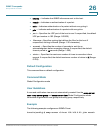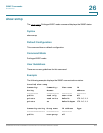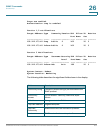
SNMP Commands
snmp-server engineID local
SPS208G/SPS224G4/SPS2024 Command Line Interface Reference Guide 347
26
User Guidelines
To use SNMPv3, you have to specify an engine ID for the device. You can specify
your own ID or use a default string that is generated using the MAC address of the
device.
If the SNMPv3 engine ID is deleted or the configuration file is erased, SNMPv3
cannot be used. By default, SNMPv1/v2 are enabled on the device. SNMPv3 is
enabled only by defining the Local Engine ID.
If you want to specify your own ID, you do not have to specify the entire 32-
character engine ID if it contains trailing zeros. Specify only the portion of the
engine ID up to the point where just zeros remain in the value. For example, to
configure an engine ID of 123400000000000000000000, you can specify snmp-
server engineID local 1234.
Since the engine ID should be unique within an administrative domain, the
following is recommended:
Use the default keyword to configure the engine ID.
Changing the value of the engine ID has the following important side-effect. A
user’s password (entered on the command line) is converted to an MD5 or SHA
security digest. This digest is based on both the password and the local engine ID.
The user’s command line password is then destroyed, as required by RFC 2274.
As a result, the security digests of SNMPv3 users become invalid if the local value
of the engine ID change, and the users will have to be reconfigured.
You cannot specify an engine ID that consists of all 0x0, all 0xF or 0x000000001.
The show running-config Privileged EXEC mode command does not display the
SNMP engine ID configuration. To see the SNMP engine ID configuration, enter the
snmp-server engineID local Global Configuration mode command.
Example
The following example enables SNMPv3 on the device and sets the local engine
ID of the device to the default value.
Console(config) # snmp-server engineID local default


















